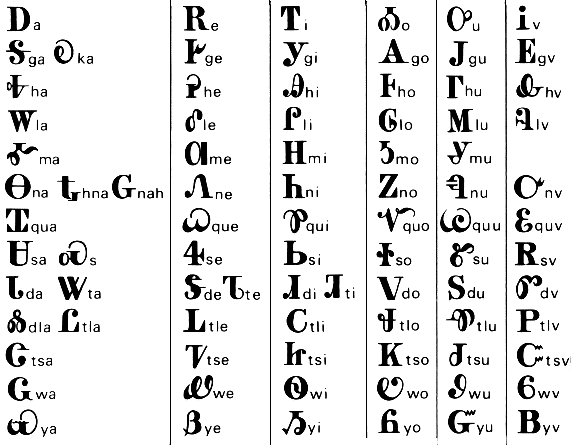Cherokee Triumph

They
may have lost their land, brothers, and freedom in the past,
but in creating
and using the Cherokee language for over 187 years, the
Cherokee culture
overcame and survived the American front. The Cherokee written
language
consists of 86 characters, each representing a certain
syllable of the Cherokee
spoken word. It was founded and established by Sequoyah, a
native tribe member,
after seeing and coming to know the White Man’s written
speech. Existing still
today are several main groups of Cherokees; one remaining in
Oklahoma, an
Eastern band, the United Keetoowah Band, and some peoples live
along the West
coast. There is a sum of 200 groups, bands, or peoples that
fall under Cherokee
title and continue practice traditional Cherokee customs (like
that of the
Cherokee language) in this day and age. By choosing to
acculturate, rather than
simply assimilate into American life, the Cherokee nation
built a defense
against American power that would supply them the chance of
independence—remaining
to be solely Cherokee amidst American society. Incorporating
American
mechanisms like media and government allowed for an
intellectual upper-hand
that set the Cherokee apart from the rest. Rather than
improving war skills,
the Cherokee could combat Americanism with Americanism,
resulting in a stronger
chance of their survival, culturally and physically. This
upper-hand would not
have manifested without the invention and establishment of the
Cherokee written
language. In supplying the Cherokee people with written
language, each member
was empowered to fight for an everlasting future, with
Cherokee culture still
intact.
Primary Sources
Boudinot, E. The Cherokee Phoenix, June 17, 1829, Editorial
section, http://www.cerritos.edu/soliver/Student
Activites/Trail of
Tears/web/boudinot.htm
As the first editor of the first
ever Native
American newspaper, the “Cherokee Phoenix,” it was interesting
to read and
understand the trials of the Cherokee during the time before
their removal to
Oklahoma. Ultimately, the largest conflict for the Cherokee
was battling the
Indian Removal Act, as seen here, through the eyes of a native
and
intellectual, Elias Boudinot. Boudinot represented and helped
to guide the
literacy movement that followed the establishment of language.
Daryus, H. "The Complete Periodical
Library." The Cherokee Phoenix and Indians' Advocate,
May 14 25, 1834.
In researching the newspaper of
the Cherokee, it
was necessary to find an actual archive of their paper.
Reading first hand of
the issues and solutions-in-the-works for the Cherokees during
the 1800’s was
important in chronicling their rise to power against the
American front.
Jackson,
A.
"To the Cherokee Tribe of Indians East of the Mississippi
River." Macon Weekly Telegraph, April 09, 1835, IX section, 2
edition,
http://www.teachushistory.org/indian-removal/resources/cherokee-tribe-indians-jackson
(accessed
March 20, 2012).
After learning of the Cherokee
perspective, it
was important to understand the perspective of the opposition:
the Americans.
Leading the Indian Removal Act after George Washington’s
presidency, Andrew
Jackson was successful in removing the majority of the Eastern
Indian tribes to
the West, namely the Cherokee. In this letter written, Jackson
warns the
Cherokee of their resulting demise if they continued to govern
and live on the
Eastern side.
Secondary
Sources
Anderson, W. Encyclopedia of North Carolina.
http://uncpress.unc.edu/nc_encyclopedia/cherokee.html
(accessed April 22,
2012).
Anderson, a compiler of
information for the North
Carolina Encyclopedia, chronicled much of the history of the
Cherokee. This source
listed when, where, and why the Cherokee acculturated quicker
than most.
Anderson talks greatly of their successes in language and
government as part of
the Cherokee’s main reasons for surviving so long.
Diamond,
Jared. Guns,
Germs, and Steel: The
Fates of Human Societies. New York: W. W.
Norton & Company, Inc., 1999. (accessed
March23, 2012).
Although Diamond’s book focuses
on the cultures
of the entire world, Diamond mentions the efforts of Sequoyah
and the rise of
the Cherokee language. In his book, Diamond talks of how
geographically
cultures develop differently. He argues here that developing
such a language
early on helped to advance the Cherokee at different rates
from their
surrounding tribes.
Gnanadesikan, A. The
Writing Revolution:
Cuneiform to the Internet (The Language Library). Wiley-Blackwell,
2008. (accessed April
20, 2012).
In her book, Amalia Gnanadesikan
writes of several languages devised by
cultures like the Cherokee. She too touches on Seqouyah
and his trials and triumph. She discusses how the language
permeated the
villages and became more popular in the schools and tribe as a
whole.
Strickland,
R. Encyclopedia of Oklahoma History and Culture.
http://digital.library.okstate.edu/encyclopedia/entries/C/CH014.html
(accessed
March 23, 2012).
Strickland, like Anderson,
compiled several
sources to write of the Cherokee culture for the Oklahoma
Encyclopedia. He
follows the developments of the Cherokee in relation to their
government and
incredible literacy rates.